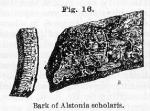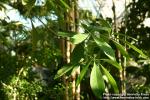
 Preparation: Fluid Extract of Alstonia Scholaris
Preparation: Fluid Extract of Alstonia Scholaris
Related entry: Alstonia Constricta.—Alstonia Bark
The bark of Alstonia scholaris, R. Brown.
Nat. Ord.—Apocynaceae.
COMMON NAMES: Dita bark, Devil tree of India.
ILLUSTRATION: Bentley and Trimen, Med. Plants, 173.
Botanical Source.—Alstonia scholaris (Dita bark), is found throughout tropical Eastern Asia and the Malayan Archipelago (Bentham). It is a large tree, with smooth, entire, thick leaves disposed in whorls. The flowers resemble those of Alstonia constricta, but differ in having corolla tubes about three times as long as the calyx, and shorter pubescent lobes. The pods are slender and over a foot long. Don says it is a native of the East Indies and the Moluccas; the bark met with in commerce comes from the Phillippine and neighboring islands, and is the portion used in medicine. The local name of the bark is satween. As a remedial agent dita is old, having been mentioned, it is said, by Rheede (1678), and Rumphius (1741).
Description.—Dita bark is about ½ inch thick, and is found in market in irregular sizes from 1 to 2 inches wide, and from 3 to 6 inches long. Externally it is of a mottled pinkish or brownish and white color, rather smooth, but marked by shallow fissures which are raised upon the edges and scarcely extend through the corky layer. The cork, a very thin layer, represented by the dark edge of the section b of our engraving, is brown. Internally, the color of the bark is light, slightly striated with yellowish layers or grains. In texture it is granular and brittle, resembling wild cherry bark from old trees. The taste is slightly bitter, free from astringency, not unpleasant, and may be compared to the aftertaste of wild cherry bark, and in like manner the bark is gritty between the teeth.
Chemical Composition.—According to Husemann, Scharlée, in 1863, published an article on the preparation of an alkaloid which he named alstonine. Gruppe found in it about 2 per cent of a substance which possessed febrifuge powers, and he named it "ditain." It was prepared, according to Hildwein, in a manner similar to that used in making quinine; it is not an alkaloid, but a mixture of substances, as was verified by Gorup-Besanez, who found it to contain a crystallizable substance possessing the properties of an alkaloid. Jobst and Hesse (1875), separated the true alkaloid, ditamine (C16H19O2), from the bark, as a white amorphous powder, slightly bitter, soluble in ether, chloroform, benzene, and alcohol, being alkaline in reaction from the latter solution. It forms soluble salts, with diluted acids, which are very bitter; it dissolves with a reddish color, in sulphuric acid, and yellow in nitric acid, turning dark green at first when heated, then orange-red, with evolution of fumes of the same color. It was obtained only in about 0.02 per cent of the bark operated upon, and on this account can never be expected to come into general use as a febrifuge. A second alkaloid, ditaine (crystallizable) was obtained by Harnack in 1877, for which Hesse, in 1880, found the formula C22H28N2O4, and changed the name to echitamine. Besides, Hesse discovered a brown amorphous alkaloid which he named echitenine (C20H27NO4). In addition, there are present oxalate of calcium, fatty acid, crystallizable acid, and several fatty resinous substances called: Echicaoutchin (C25H40O2); echicerin (C30H48O2); echitin (C32H52O2); echitein (C42H70O2); echiretin (C35H56O2). These substances closely resemble resins obtained from other sources. Doubtless, the bark, if employed in medicine, will be either used in substance or in the form of tincture or fluid extract, as the proximate principles can not become of much commercial importance.
History.—In Ceylon coffins are made of this light wood (Treasury of Botany). According to Drury, the name "scholaris" is derived from the fact that its planks, when sanded, were used by school children for tracing letters. It is largely used in India for skin disorders (Dutt, Hindu Mat. Med.), and as a febrifuge. According to Graham, the natives have a superstitious reverence for this tree, believing that all the forest trees assemble once a year to pay homage to it (Dymock). This bark is largely used by the natives of India (where it is official in the Pharmacopoeia), as a remedy for bowel disorders, and to restore the tone of the gastrointestinal tract after exhausting sickness, as from fever (Maiden). Woolen and cotton cloths are dyed various shades of yellow with this bark (Baron von Mueller's Exhibit, Melbourne, 1866).
Action, Medical Uses, and Dosage.—Dita bark has been efficaciously employed in malarial fever; it does not, however, appear to be as prompt nor as active in its influence as the alstonia constricta bark, requiring to be used in somewhat larger doses. Alstonia scholaris has some reputation as a remedy for dysentery (Bancroft, Bixby). Its alkaloid may prove more efficient should it ever become more largely and less expensively prepared. Dose of the fluid extract, 1 to 4 fluid drachms.

